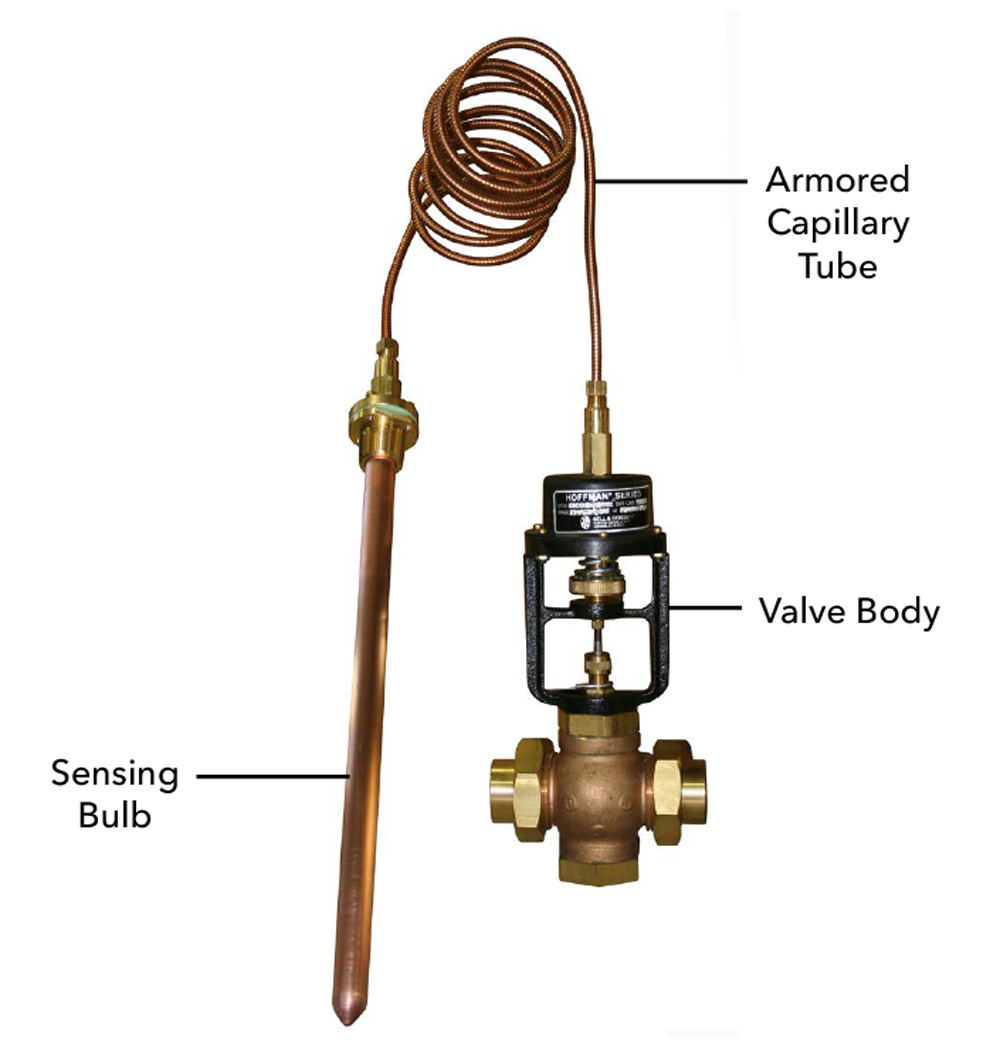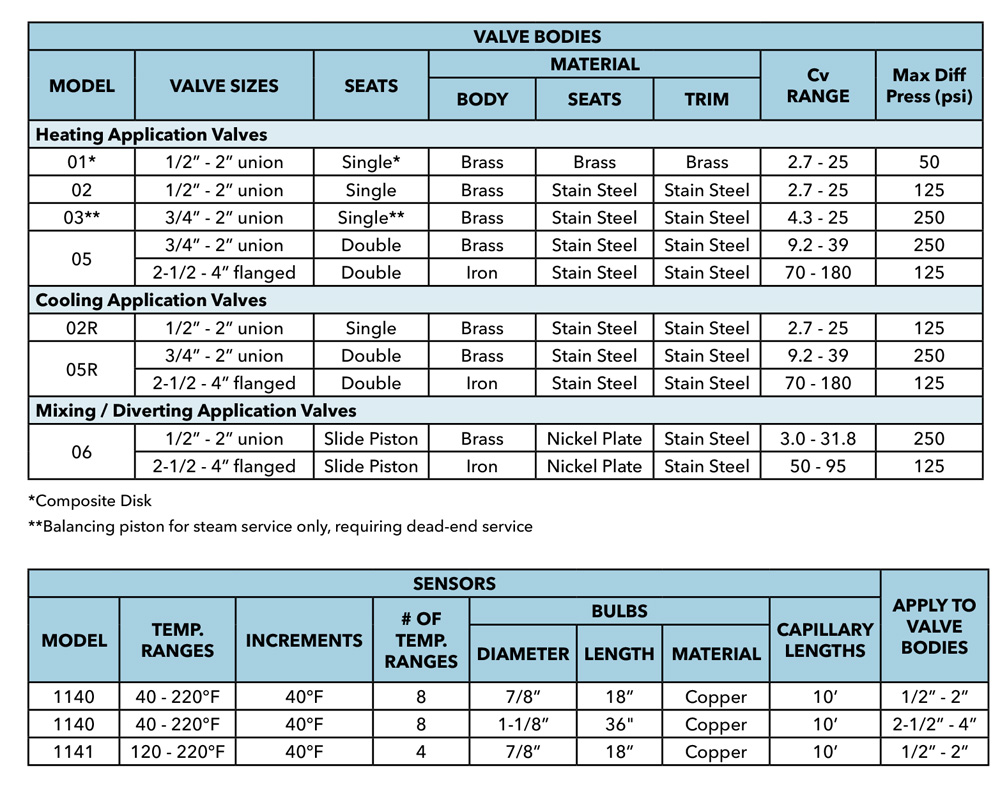
Hoffman Specialty Temperature Regulator Series 1140/1141
Volume 5/ Issue 2/ August 2018
Temperature regulators adjust the flow of steam or liquids to control the temperature of a fluid in heating or cooling equipment. Typical applications include:
- Large storage tanks that change temperature gradually
- Shell and tube heaters that require instant response
- Steam tables
- Oil preheaters
- Sterilizing equipment
- Textile dryers
- Processing equipment.
- Cooling equipment
For effective temperature control, you need to choose the right regulator, correctly size the valve, and properly locate and install the regulator. For the best steam heating system performance, you also need proper trap sizing, location and installation.
All temperature regulators include a valve (body) and a sensor (actuator). The actuator unit’s bulb must be fully immersed in the fluid where temperature is to be controlled. Regulator bulbs are filled with a fluid that expands with heat, enabling the valve to increase or reduce the flow of the heating media in proportion to the sensed temperature deviation.

Series 1140 and 1141 self-actuated vapor-pressure type temperature regulators
Series 1140 and 1141 self-actuated vapor-pressure type temperature regulators:
- Regulate the flow of liquid or steam through a valve to maintain a set temperature in the controlled fluid.
- Consist of a valve body and an actuator/sensing unit.
- Have an attached “superstructure” that consists of a valve bracket, adjustment spring, upper stem and temperature adjustment wheel.
- Can be used in heating, cooling or mixing / diverting, depending on valve materials and internal valve configurations. For example, valves with stainless steel discs generally can withstand higher pressure differentials than valves with composition discs. Heating or cooling applications typically require two-port valve bodies, while mixing / diverting uses three-port bodies.
- Are self-sensing and self-actuating, requiring no auxiliary power source to operate the valve or detect a temperature change in the medium (fluid) whose temperature is being controlled.
The sensing units (actuators) have:
- Sensing bulbs that must be fully immersed in the fluid where temperature is to be controlled.
- Sensing bulbs filled under vacuum with a volatile fluid.
- An armored capillary tube that carries the volatile fluid from the sensing bulb to a bellows that
operates the valve. - Bellows that:
- Are compressed by the vacuum in the sensing bulb and capillary tube when the sensing bulb is cold.
- Expand with rising vapor pressure when the volatile fluid vaporizes as the sensed temperature increases.
- Amplify the force of the vapor pressure, generating thrust to overcome the adjusting spring and push on the valve upper stem. The over-balancing of the spring force by the bellows moves the valve stem.
You can manually operate the adjustment wheel to vary the spring compression, setting the valve to close at any point in the sensing bulb’s temperature range. For best results, the temperature set point should be in the upper half of the temperature range.
In a heating regulator, a direct acting valve seat is:
- Held open by the adjustment spring.
- Closed by the movement of the bellows on the valve stem.
When the volatile fluid is below its saturation temperature, the vacuum inside the bulb pulls the bellows away from the valve stem. As the volatile fluid’s temperature increases, the expanding bellows close the valve, shutting off the flow of steam or other heating medium to the heat exchanger.
For cooling applications, the reverse acting valve seat is:
- Held closed by the adjustment spring.
- Opened by movement of the bellows on the valve stem.
An increase in the volatile fluid’s temperature causes the expanding bellows to open the valve, allowing more water or other cooling medium to flow to and through the heat exchanger.
In mixing / diverting water systems, the valve body has three ports. The actuator bellows control the
position of a valve piston.
- In a mixing valve, the piston position determines how much hot water from one side port is mixed with cold water from the other side port. The blended temperature combination exits via the valve’s third, or bottom, port.
- In a diverting valve, fluid enters from the valve’s bottom port. The piston position determines how much water exits via the two side ports. When the medium temperature is below the actuator temperature range, all fluid exits one side port. When the medium temperature is above the set point, all fluid exits the other side port. As the valve modulates within the actuator’s control range, fluid discharges from both side openings.
Fluids with various boiling points are used to achieve varying actuator/sensor control temperature ranges. Series 1140 and 1141 temperature regulators offer eight temperature range actuators from 40ºF to 220ºF (4.4ºC to 104ºC). Each temperature range actuator provides 40ºF (4ºC) temperature adjustment.
Series 1140/1141 offers 5 body styles:
- Single and double seats for heating and cooling – 3-valve bodies with stainless steel seats and trim
- Sliding piston for mixing / diverting
- Brass or iron bodies, depending on valve size
- Union ends – 1/2” to 2”
- Flanged ends – 2-1/2” to 4”
Series 1140/1141 actuators:
- 8 temperature ranges for all valve body styles
- 40° F temperature range increments
- 10’ capillary length standard
- 100°F overprotection
- ± 10°F control accuracy
- Copper bulb
- 3 bulb diameter / lengths, depending on valve size

For more information on Hoffman Components Selector click here.
For more information on Series 1140/1141 click here.

